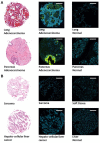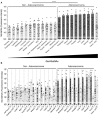Tumor Targeting by Fusobacterium nucleatum: A Pilot Study and Future Perspectives
- PMID: 28713780
- PMCID: PMC5492862
- DOI: 10.3389/fcimb.2017.00295
Tumor Targeting by Fusobacterium nucleatum: A Pilot Study and Future Perspectives
Abstract
Colorectal adenocarcinoma (CRC) is a common tumor with high mortality rates. Interestingly, CRC was found to be colonized by the oral anaerobic bacteria Fusobacterium nucleatum, which accelerates tumor progression and enables immune evasion. The CRC-specific colonization by fusobacteria is mediated through the recognition of tumor displayed Gal-GalNAc moieties by the fusobacterial Fap2 Gal-GalNAc lectin. Here, we show high Gal-GalNAc levels in additional adenocarcinomas including those found in the stomach, prostate, ovary, colon, uterus, pancreas, breast, lung, and esophagus. This observation coincides with recent reports that found fusobacterial DNA in some of these tumors. Given the tumorigenic role of fusobacteria and its immune evasion properties, we suggest that fusobacterial elimination might improve treatment outcome of the above tumors. Furthermore, as fusobacteria appears to specifically home-in to Gal-GalNAc-displaying tumors, it might be engineered as a platform for treating CRC and the above common, lethal, adenocarcinomas.
Keywords: Fusobacterium nucleatum; Gal-GalNAc; adenocarcinoma; bacterioncology; cancer.
Figures


References
Publication types
MeSH terms
Substances
LinkOut - more resources
Full Text Sources
Other Literature Sources
Medical

